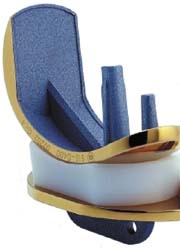Uncemented AMC Uniglide knee arthroplasty
K U Brust, of the Division of Surgery, Oncology, Reproductive biology and Anaesthetics, Faculty of Medicine, Imperial College London, UK, and G Bontemps of the Fabricius Klinik, orthopedic department, Remscheid, Germany, report on mid- to long-term results

Unicompartmental Knee Arthroplasty (UKA) is a commonly used, successful treatment for both medial and lateral compartment knee osteoarthritis (OA); over the past decade its use has increased in younger, more active patients. The AMC Uniglide system offers a cemented and an uncemented device; however, there is still a reluctance to use the uncemented alternative as they are thought to be not as satisfactory.
In the younger patient both the polyethylene and the prosthesis/bone fixation has to withstand greater forces and hence is at increased risk of failure. Our study compares the clinical and functional outcome of the cemented (Fig 1) and uncemented versions of the Uniglide and focuses on the issue of reliable prosthesis/bone fixation.
Method
The Uniglide aims to afford congruent surface area contact together with physiological kinematics by replicating the normal morphology of the femoral condyle. This construct, together with unrestricted movement of the polyethylene bearing on the tibial plateau, gives intrinsic stability and helps protect the implant-bone fixation. The Titanium Nitride coating on the articular surface of the Uniglide is wear and corrosion resistant, reducing the coefficient of friction thereby reducing polyethylene wear. The surface of the uncemented implant has a titanplasmaspray (Fig 2) and thin electro-chemically applied calciumphosphate coating to accelerate component/bone osteo-integration.
We performed 477 cemented (patient age 60-94 years, mean 71) and 137 uncemented Uniglides (patient age 40-79 years, mean 65) from Jan 1991 to Dec 2003. Both groups were gender matched with patients studied for a mean of eight years (2-14), four percent were lost to follow up. All patients were assessed functionally using the Knee Society knee scoring system and radiologically with plain X-rays (FC Ewald).
Results
The knee score (pre/post op) for both groups are as follows: for the cemented 35/94 and uncemented 36/94 respectively. Function Score (pre/post) cemented 52/90 and uncemented 54/92 (Fig 3). Range of movement was increased by 16° for the cemented group whilst for the uncemented the increase was 20°.
Patient assessment (cemented/uncemented) was rated as excellent 72%/75%, good 20%/18%, fair 5%/5%, poor 3%/2%.
Two percent of the cemented group required revision due to component loosening, compared with 1.5 percent in the uncemented group. The radiological assessment showed less radiolucent lines at the bone component interface in the uncemented group.
Conclusion: The Uniglide prosthesis gives excellent results in both groups with the knee and function scores showing similar improvement. The loosening rate in the uncemented cohort is lower despite the higher physical demands in this younger age group (mean 6 years).
The uncemented prosthesis is a successful alternative for younger patients (< 70 years) and is a very attractive option that bolsters the minimally-invasive surgical approach used in UKA.
30.10.2007


